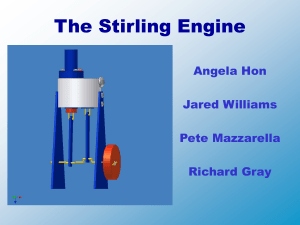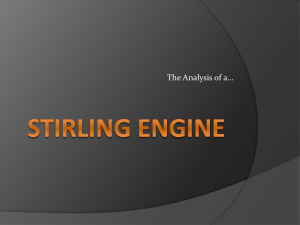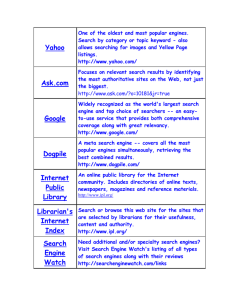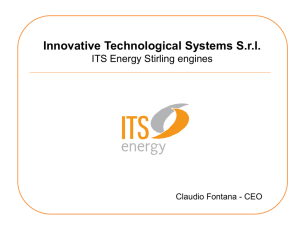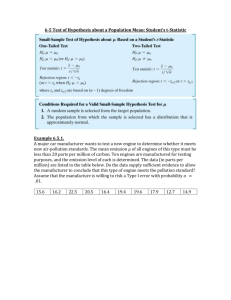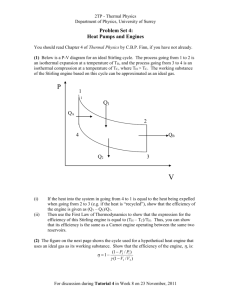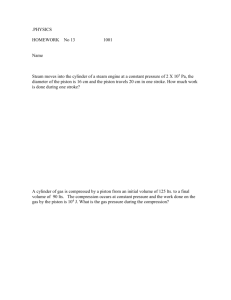Stirling Engine - Gaby Waldman
advertisement
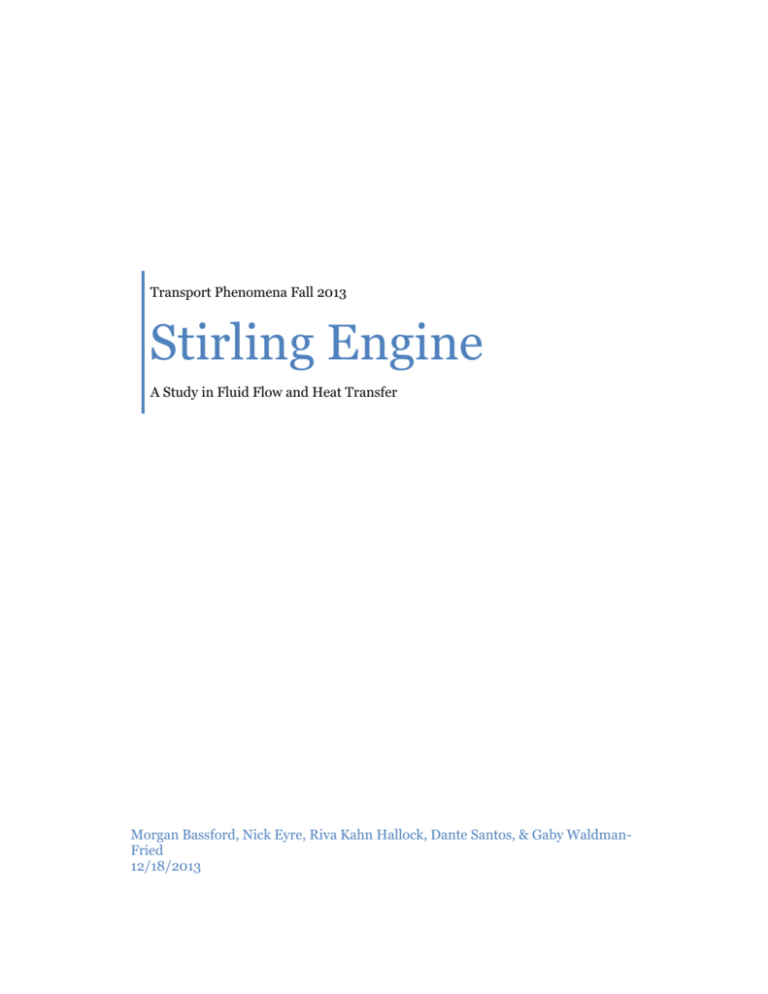
Transport Phenomena Fall 2013 Stirling Engine A Study in Fluid Flow and Heat Transfer Morgan Bassford, Nick Eyre, Riva Kahn Hallock, Dante Santos, & Gaby WaldmanFried 12/18/2013 1 Table of Contents Abstract ..................................................................................................................................... 3 Background & Motivation .......................................................................................................... 3 Available Technologies ............................................................................................................... 4 Problem/Challenge Statement ................................................................................................... 5 Project Goals and Objectives ...................................................................................................... 5 Materials and Methods .............................................................................................................. 6 Engine Prototype 1: Beta Type Aluminum Can Engine............................................................ 6 Engine Prototype 2: Gamma Type Machined Engine .............................................................. 7 Analysis & Discussion ................................................................................................................ 8 Fluids ..................................................................................................................................... 8 Heat ....................................................................................................................................... 9 Dynamic Simulation .................................................................................................................10 Simulink Modeling....................................................................................................................12 Conclusions ..............................................................................................................................12 Reflection on Goals and Objectives ........................................................................................12 Lessons Learned ....................................................................................................................12 Appendix: Equations.................................................................................................................14 Equations of Heat Transfer in Transport Phenomena ...............................................................14 Convection (Forced) ..............................................................................................................14 Convection (Natural or Free) .................................................................................................14 Conduction ............................................................................................................................15 Radiation...............................................................................................................................15 For The Stirling Engine Project .................................................................................................15 Q1 - Forced Convection – Boiling Water ...............................................................................15 Q2 – Conduction – Bottom Plate ...........................................................................................16 Q3 – Convection – Working Fluid .........................................................................................16 Q4 – Conduction – Top Plate ................................................................................................17 Q5 – Natural Convection – Ice Water ....................................................................................18 Total Heat Transfer ...................................................................................................................18 2 Table of Figures Figure 1: Gamma type engine (left) and a beta type engine (right). ............................................... 4 Figure 2: Our first “soda can” Stirling engine prototype. ............................................................... 6 Figure 3: CAD render of our second prototype. The crankshaft and flywheel are hidden. .............7 Figure 4: A simplified heat flow diagram of our Stirling engine design. Air is heated and cooled by the two plates as it compresses and expands in the two chambers. The crankshaft and flywheel are hidden. ........................................................................................................................ 8 Figure 5: the five stages of heat transfer within the Stirling Engine. ............................................. 9 Figure 6: a picture of the temperatures within our Stirling Engine under operating conditions. . 9 Figure 7: Note that with a negative initial velocity, the system corrects and stabilizes at a positive rotational velocity. ......................................................................................................................... 11 3 Abstract Stirling engines are closed-cycle heat engines that work by the cyclic convection driven expansion and contraction of a gas. Due to its high Carnot efficiency, the Stirling engine can be practically driven by a wide variety of heat sources. In this project, we examined the design and characterization of a low temperature differential Stirling engine designed to be powered by an organic energy source. We began by building a very lowcost (VLC) beta-type Stirling engine prototype which suffered from high frictional losses and provided some proof of concept but was not fully functional. Next we built a second prototype, a gamma-type design designed to have low friction and be much more efficient than the first prototype. The second prototype, while based on a known design, was substantially modified to optimize manufacturability and ease characterization while maintaining similar performance. It was functional, and we worked to simulate and characterize the engine’s heat transfer and fluid flow. Finally, we created a simplified dynamic simulation which aligned with our experimental results. Background & Motivation Stirling engines are closed-cycle heat engines that generate power through the Stirling cycle. In a Stirling engine, a working fluid (commonly air, although noble gases are frequently used in high-performance engines to reduce explosion risks) is compressed and heated with an external heat source.1 The working fluid expands, pushing on a piston (the power stroke) and then is forced to the cool area with a displacer piston. Once the gas cools, it is compressed by the pistons as they continue to move from the momentum stored in the flywheel.i1 The compressed gas is then heated and the cycle begins again. Stirling engines are still in development for many industries, but are most often used in hybrid technologies or to power pumps. Stirling engines are heat engines and can run on much smaller temperature differentials than the their internal combustion cousins.1 Furthermore, their external heat source need not necessarily be a product of combustion--they may be run on sustainable alternatives such as solar, compost, bio-gas and steam. This makes them a very attractive technology to developing nations, and follows with the UN Millenium Development Goal, “Ensure environmental sustainability”. Our aim is to possibly also address the National Academy of Engineering’s Grand Challenge entitled “Make solar economical”. However, the precision and materials typically required in the manufacture of Stirling engines have hampered their widespread adoption in countries that could benefit from them most. No industrial-scale solar Stirling plants currently operate in the United States despite attempts to implement them in heavily sunlit states. In 2010, Stirling Energy Systems commissioned and built the 1.5 MW Maricopa plant (a single unit proof of concept) in Arizona with future plans to build two additional full scale plants (709 MW and 850 MW). Unfortunately they did not have sufficient equity to finish the additional 4 plants and the Maricopa Plant closed in 2011 after the company went bankrupt trying to fund the additional projects.ii However, full scale solar Stirling plants exist in Germany and other European countries. In terms of power generated per unit area of space, solar Stirling plants are superior to photovoltaics. The average efficiency of the Carnot cycle with an 100 degree temperature differential is 17%, which is higher than the average efficiency of a solar cell at 12%. Furthermore, industrial scale solar Stirling engines operate at a 700 degree temperature differential which gives a 30% Carnot efficiency.iii However, due to incredibly high manufacturing and maintenance costs (largely driven by the tight tolerances required by the engines to function), solar Stirling plants are not a viable option for large scale energy generation, especially in developing nations. Available Technologies Figure 1: Gamma type engine (left)iv and a beta type engine (right)v. We have chosen to build one beta and one gamma type Stirling engine. A beta Stirling engine has a single power piston and a displacer mechanism. Gas is exchanged between expansion and compression spaces through a temperature gradient. In gamma Stirling engines, the power piston and displacer are in different cylinders. While gamma Stirling engines require less of a temperature differential to function, they also produce less specific power. Stirling engines of a variety of types, sizes, and qualities can be purchased in kit form as well as fully assembled. We borrowed a low temperature differential Stirling engine kit, which cost $98 for a small engine. The gamma type that we built cost us $150 for materials and was designed to produce less than 10W of power. 5 Problem/Challenge Statement In general, Stirling engines are not known for their overall general efficiency nor cost-effectiveness. Our biggest challenge was to create a more efficient, working Stirling engine out of readily available materials. It is particularly challenging to create a lowcost Stirling engine that runs on very low temperature differentials. We designed a Stirling engine to run on the heat generated by hot compost. Hot compost can hit maximum temperatures of around 160oFvi, giving us a temperature differential of around 130-140 degrees F to work with. According to our research, an engine operating with a temperature differential of ~130oF should yield a maximum thermal (Carnot) efficiency of about 17.4%vii. Stirling engines have a high theoretical efficiency but characteristically low efficiency in practice because it is difficult to maintain a large enough temperature differential for the engine to function: either heat is lost to the environment or the cool side of the engine heats up via conduction through the device. It has been a challenge to reach or exceed even this percent efficiency using the naturally occurring heat from organic matter decomposing. Project Goals and Objectives We wanted to pursue two consecutive physical prototypes, a mathematical model and simulations for both fluid flow and heat transfer in the system. We completed a sketch model of a beta type engine (with power output of less than 10W) using found materialsviii, and used what we learned from that to make a larger Stirling. Then, using the specifications and measurements from the gamma engine, we wanted to create mathematical models of the system. Eventually we used simulations to derive what changes could be made to the engine in order to increase its efficiency to cost ratio. 6 Materials and Methods Engine Prototype 1: Beta Type Aluminum Can Engine Figure 2: Our first “soda can” Stirling engine prototype. To better understand the difficulties involved in building Stirling engines, we began by constructing a beta type engine out of found materials according to the instructions on Scraptopower.comix. This proof of concept allowed us to experiment with the amount of heat needed to overcome the shaft resistance. Unfortunately, imprecise components and assembly lead to major friction losses (primarily around the crankshaft) that ultimately did not allow our beta type to generate enough power to have the flywheel spin freely. However, we did notice that the flywheel spun more easily with a temperature differential--i.e., when the hot end of the engine was placed in boiling water--so it probably would have worked if our assembly had been more precise. Experimentation with the beta type model highlighted the importance of assembling and manufacturing our components carefully and within tolerances, especially the crankshaft. 7 Engine Prototype 2: Gamma Type Machined Engine For our second prototype, we built a gamma type Stirling engine roughly based on plans from ridders.nu. We decided to use a known design to reduce the uncertainties in our design process and allow us to focus on the analysis and characterization rather than design of the system. Gamma type engines are similar to beta engines but have an offset power piston, which simplifies them mechanically and reduces the weight of the power piston. This engine is constructed from two aluminum plates which form the top and bottom edges of a large diameter cylinder. The plates are round because it is easier to machine round parts to a higher tolerance. The two plates are also insulated from each other by a plastic cylinder and plastic standoffs. Aluminum was chosen for its ease of machining and high thermal conductivity. The displacement piston is constructed of a round disk of balsa wood, chosen for its light weight and ease of machining. The displacement piston is machined from graphite--selected for its low coefficient of thermal expansion and self-lubricating properties--and slides in a glass tube. A pair of aluminum plates support a crankshaft in ball bearings above the top plate of the system. The crankshaft is manufactured from steel shaft brazed to connecting offset links. Connecting rods attach the crankshaft to the power and displacement pistons. A CAD render of our design (without flywheel and crankshaft) is shown below. Figure 3: CAD render of our second prototype. The crankshaft and flywheel are hidden. 8 Analysis & Discussion Figure 4: A simplified heat flow diagram of our Stirling engine design. Air is heated and cooled by the two plates as it compresses and expands in the two chambers. The crankshaft and flywheel are hidden. Fluids A Stirling engine is a closed system, using the relationship between temperature and pressure at a constant volume to derive work from a temperature difference. As such, there is no bulk flow of fluid. The displacer piston shuttles fluid back and forth between the hot and cold plates and fluid expands into the power piston, but there is no net flow in and out. To characterize the flow that we do have, we assumed that the engine is working between 1 and 10 Hz. Assuming this frequency and taking into account the geometries of our engine, the volume of fluid displaced is so small that the flow everywhere can be taken as laminar. There are no doubt vortices caused by the geometry of the engine, but the flow itself is not turbulent. This is somewhat unfortunate because the boundary layer in laminar flow is much thicker than in turbulent flow, reducing the heat transfer from a fluid to a wall. We want to maximize the heat transfer between the plates and the working fluid, and therefore make the flow along the plates turbulent. There are methods of roughing the surface just enough to make the flow turbulent without creating pockets of stagnant fluid that could be used to increase this heat flow. 9 Heat The fluid flow in our system is not particularly interesting, but the meat of the project lies in the ways that heat is transferred. The Stirling engine works off of a temperature difference and five stages of heat transfer. As shown in Figure 5, the heat is transferred from the source (in this case, a pot of boiling water) to the bottom plate of the engine, to the working fluid, which is then forced to transfer heat to the top plate of the engine, which transfers heat to the ice water bath. The total heat transfer through the system is 307 Watts. This is not the amount of power that our engine outputs. That would be determined by a series of ideal gas law and torque equations. Our calculations to acquire these numbers can be found in the Appendix. Figure 5: the six stages of heat transfer within the Stirling Engine. Figure 6: a picture of the temperatures within our Stirling Engine under operating conditions. Figure 6 is a picture taken by an IR camera displaying the temperatures of our engine in Fahrenheit. The white oval near the bottom is the flame, the red area above it 10 the iron ring from the ring stand on which we were resting the engine, above that is the green and blue bottom plate, then the spectacular gradient of the working fluid of the engine, followed by the very cool upper plate. We hypothesize that the bottom plate is not the same red as the ring stand and the bottom most air because the portion that the camera can see is exposed to the ambient air and cools quickly. We assume that the portion of the bottom plate closer to the flame is much warmer. Dynamic Simulation A dynamic simulation was made in MATLAB to help understand the behavior of our engine. The simulation simplifies our system into a hot and cold chamber with a displacer piston that moves the air betweenx. The cold chamber contains the region of the power piston cylinder below the piston. The simulation has two state variables: the rotational position and velocity of the crankshaft. These in turn are used to calculate the positions of the pistons and the volumes of the two chambers. The system applies the simplifying assumption that the gas in each chamber is of uniform temperature and uses the ideal gas law to calculate the pressure of the two-volume system. This pressure creates a force on the power piston which creates a moment on the crankshaft, causing the system to continue spinning. Viscous damping is applied on the crankshaft to counteract the force from the engine. An animation was used to visualize the system. Due to the viscous damping, the system asymptotically stabilizes at a rotational velocity and power output. The power output of the simulated system is very low (< ¼ W). Note that this is an idealized version of the system. As verified by thermal imaging, the actual engine has a temperature gradient across the displacement cylinder, resulting in lower effective temperatures and less pressure in the system. The simulation was compared to the second prototype engine and matched up very well. The geometry was equivalent to our prototype and when tested with a 100 K temperature differential and a viscous damping coefficient of 0.1 Newton-seconds, the system stabilized at a rotational speed of about 1 rotation per second, just as our prototype did (Figure 7). Using the simulation, we performed some system and geometry optimization studies. We found that the larger the diameter of the power piston, the higher the power produced. This makes sense as there is a larger area for the pressure to act on. When taken to the limit of the diameter of the displacer piston, a beta type Stirling engine results. However, this is a trade-off with the increased rotational mass of the crankshaft caused by a larger power piston. Next, we looked into the effect of the contained gas on performance. We found that when alternative gases are used, atmospheric pressure 11 overpowers the pressure within the engine and causes decreased performance. We also found that the taller the displacement cylinder, the higher the power output of the system. This aligns with the expected behavior as there is more gas present to expand and contract. Furthermore, we found that the diameter of the displacer piston is not especially critical to the performance of the system. Figure 7: Stirling Engine Dynamic Simulation. Note that with a negative initial velocity, the system corrects and stabilizes at a positive rotational velocity. 12 Simulink Modeling We attempted to model heat flow, temperature and pressure using Simulink in MATLAB. However, due to difficulty modeling thermo-fluid systems using the Simulink software we did not achieve this goal. We did successfully complete a model showing temperature changes as the fluid is heated and cooled via conduction and convection. Figure 8: Simulink Diagram for Heat Flow in the Stirling Engine Conclusions Reflection on Goals and Objectives In the end, we did accomplish our goal of creating two physical prototypes, a mathematical model, and simulations for fluid flow and heat transfer. Though the first prototype was not fully functional, we learned a lot for the next iteration. The gamma engine helped us collect data regarding the heat transfer in our model; we were able to show why the theoretical efficiency of a Stirling engine and the actual efficiency are so different. Lessons Learned The power to cost ratio of Stirling engines is far too low for them to be a viable energy source. Our Stirling engine produced a sub-watt power output, rendering it nearly useless for any energy applications. On top of that, Stirling engines are precision machines that rely on near-perfect machined parts to work. Because of this, a Stirling engine would probably not be the right choice for power generation in the developing world. Solar panels are impossible to repair on site, but they are becoming more and more mass-produced, meaning their price is being driven down daily. A Stirling engine 13 would be near-impossible to service, and implausible to make locally with any desirable success rate. The only way this could become a viable solution is if significant startup capital was put into creating millions of small temperature difference Stirlings that could be sold at low cost in developing countries. Recommendations and Future Work If anyone wanted to pursue this in the future, we would recommend optimizing the geometries of the pistons, the insulative nature of the walls, and the thickness of the top and bottom plates. It would be valuable to have a machine shop manufacture parts that could reach the necessary tolerances. For us, air leakage around the power piston and chamber was the difference between the engine working or not so it would be necessary to have the Stirling engine precision machined. Another future pursuit working off this model would be to collect experimental data (pressure, temperature, displacer piston velocity, flywheel rpm, etc.) off of the engine to compare with and validate simulation values. 14 Appendix: Equations Equations of Heat Transfer in Transport Phenomena Convection (Forced) 𝑅𝑒 → Pr → 𝑁𝑢 → ℎ → 𝑄̇ 𝜌𝑉𝐷 𝑅𝑒 = 𝜇 𝑤ℎ𝑒𝑟𝑒 𝜌 = 𝑑𝑒𝑛𝑠𝑖𝑡𝑦, 𝑉 = 𝑣𝑒𝑙𝑜𝑐𝑖𝑡𝑦 𝑜𝑓 𝑓𝑙𝑢𝑖𝑑, 𝐷 = 𝑐ℎ𝑎𝑟𝑖𝑐𝑡𝑎𝑟𝑖𝑠𝑡𝑖𝑐 𝑙𝑒𝑛𝑔𝑡ℎ (𝑑𝑖𝑎𝑚𝑒𝑡𝑒𝑟 𝑖𝑛 𝑡ℎ𝑖𝑠 𝑐𝑎𝑠𝑒), 𝑎𝑛𝑑 𝜇 = 𝑑𝑦𝑛𝑎𝑚𝑖𝑐 𝑣𝑖𝑠𝑐𝑜𝑠𝑖𝑡𝑦 𝜈 𝜇𝑐 𝐾 Pr = = 𝜌𝑐 𝐾 𝑤ℎ𝑒𝑟𝑒 𝑐 = 𝑠𝑝𝑒𝑐𝑖𝑓𝑖𝑐 ℎ𝑒𝑎𝑡, 𝑎𝑛𝑑 𝐾 = 𝑡ℎ𝑒𝑟𝑚𝑎𝑙 𝑐𝑜𝑛𝑑𝑢𝑐𝑡𝑖𝑣𝑖𝑡𝑦 𝑁𝑢 = .664 𝑅𝑒 .5 𝑃𝑟 .33 𝐼𝑓 𝐿𝑎𝑚𝑖𝑛𝑎𝑟 𝑁𝑢 = .037 𝑅𝑒 .8 𝑃𝑟 .33 𝐼𝑓 𝑇𝑢𝑟𝑏𝑢𝑙𝑒𝑛𝑡 𝑁𝑢𝐾 ℎ= 𝐿 𝑄̇𝑐𝑜𝑛𝑣 = ℎ𝐴∆𝑇 𝑤ℎ𝑒𝑟𝑒 𝑄̇𝑐𝑜𝑛𝑑 = 𝑡ℎ𝑒 ℎ𝑒𝑎𝑡 𝑓𝑙𝑜𝑤 𝑜𝑓 𝑐𝑜𝑛𝑣𝑒𝑐𝑡𝑖𝑜𝑛, 𝐴 = 𝑡ℎ𝑒 𝑐𝑟𝑜𝑠𝑠𝑒𝑐𝑡𝑖𝑜𝑛𝑎𝑙 𝑟𝑒𝑎, 𝑎𝑛𝑑 ∆𝑇 = 𝑡ℎ𝑒 𝑡𝑒𝑚𝑝𝑒𝑟𝑎𝑡𝑢𝑟𝑒 𝑑𝑖𝑓𝑓𝑒𝑟𝑒𝑛𝑐𝑒 Convection (Natural or Free) 𝑄̇ = ℎ𝐴𝑠 ∆𝑇 𝑤ℎ𝑒𝑟𝑒 𝐴𝑠 = 𝑠𝑢𝑟𝑓𝑎𝑐𝑒 𝑎𝑟𝑒𝑎 𝐾 𝑁𝑢 𝐿𝑐 𝑤ℎ𝑒𝑟𝑒 𝐾 = 𝑡ℎ𝑒𝑟𝑚𝑎𝑙 𝑐𝑜𝑛𝑑𝑢𝑐𝑡𝑖𝑣𝑖𝑡𝑦, 𝐿𝑐 = 𝑐ℎ𝑎𝑟𝑖𝑐𝑡𝑎𝑟𝑖𝑠𝑡𝑖𝑐 𝑙𝑒𝑛𝑐𝑡ℎ (𝑙𝑎𝑟𝑔𝑒𝑠𝑡 𝑝𝑜𝑠𝑠𝑖𝑏𝑙𝑒 𝑣𝑜𝑟𝑡𝑒𝑥), 𝑎𝑛𝑑 𝑁𝑢 = 𝑡ℎ𝑒 𝑁𝑢𝑠𝑠𝑒𝑙𝑡 𝑛𝑢𝑚𝑏𝑒𝑟 𝑁𝑢 = .54𝑅𝑎 .25 𝑤ℎ𝑒𝑟𝑒 𝑅𝑎 = 𝑡ℎ𝑒 𝑅𝑎𝑦𝑙𝑒𝑖𝑔ℎ 𝑁𝑢𝑚𝑏𝑒𝑟 𝑔𝛽∆𝑇𝐿𝑐 3 𝑅𝑎 = 𝑃𝑟 𝜈2 𝑤ℎ𝑒𝑟𝑒 𝑔 = 𝑔𝑟𝑎𝑣𝑖𝑡𝑎𝑡𝑖𝑜𝑛𝑎𝑙 𝑎𝑐𝑐𝑒𝑙𝑒𝑟𝑎𝑡𝑖𝑜𝑛, 𝛽 = 𝑒𝑥𝑝𝑎𝑛𝑠𝑖𝑜𝑛 𝑜𝑟 𝑔𝑎𝑠 𝑐𝑜𝑒𝑓𝑓𝑖𝑐𝑖𝑒𝑛𝑡, 𝜈 = 𝑡ℎ𝑒 𝑘𝑖𝑒𝑛𝑒𝑚𝑎𝑡𝑖𝑐 𝑣𝑖𝑠𝑐𝑜𝑠𝑖𝑡𝑦, 𝑎𝑛𝑑 𝑃𝑟 = 𝑡ℎ𝑒 𝑃𝑟𝑎𝑛𝑑𝑡𝑙 𝑛𝑢𝑚𝑏𝑒𝑟 𝜇𝐶 𝑃𝑟 = 𝐾 𝑤ℎ𝑒𝑟𝑒 𝐶 = 𝑡ℎ𝑒 𝑠𝑝𝑒𝑐𝑖𝑓𝑖𝑐 ℎ𝑒𝑎𝑡, 𝑎𝑛𝑑 𝐾 = 𝑡ℎ𝑒𝑟𝑚𝑎𝑙 𝑐𝑜𝑛𝑑𝑢𝑐𝑡𝑖𝑣𝑖𝑡𝑦 𝐷 𝐿𝑐 (𝑓𝑜𝑟 𝑎 𝑐𝑦𝑙𝑒𝑛𝑑𝑎𝑟) = 4 1 𝛽= 𝑇𝑓 ∆𝑇 𝑇𝑓 = 2 ℎ= 15 Conduction 1 ℎ𝐴 𝑤ℎ𝑒𝑟𝑒 𝑅𝑐𝑜𝑛𝑣 = 𝑡ℎ𝑒 𝑟𝑒𝑠𝑖𝑠𝑡𝑎𝑛𝑐𝑒 𝑑𝑢𝑒 𝑡𝑜 𝑐𝑜𝑛𝑣𝑒𝑐𝑡𝑖𝑜𝑛, 𝑎𝑛𝑑 𝐴 = 𝑡ℎ𝑒 𝑐𝑟𝑜𝑠𝑠𝑒𝑐𝑡𝑖𝑜𝑛𝑎𝑙 𝑎𝑟𝑒𝑎 𝐿 𝑅𝑐𝑜𝑛𝑑 = 𝐾𝐴 𝑤ℎ𝑒𝑟𝑒 𝑅𝑐𝑜𝑛𝑑 = 𝑡ℎ𝑒 𝑟𝑒𝑠𝑖𝑠𝑡𝑎𝑐𝑛𝑒 𝑑𝑢𝑒 𝑡𝑜 𝑐𝑜𝑛𝑑𝑢𝑐𝑡𝑢𝑐𝑡𝑖𝑜𝑛, 𝐾 = 𝑡ℎ𝑒𝑟𝑚𝑎𝑙 𝑐𝑜𝑛𝑑𝑢𝑐𝑡𝑖𝑣𝑖𝑡𝑦, 𝑎𝑛𝑑 𝐴 = 𝑡ℎ𝑒 𝑐𝑟𝑜𝑠𝑠𝑒𝑐𝑡𝑖𝑜𝑛𝑎𝑙 𝑎𝑟𝑒𝑎 ∑𝑅 = 𝑅𝑐𝑜𝑛𝑣1 + 𝑅𝑐𝑜𝑛𝑑 + 𝑅𝑐𝑜𝑛𝑣2 𝑤ℎ𝑒𝑟𝑒 𝑅𝑐𝑜𝑛𝑣1 = 𝑡ℎ𝑒 𝑟𝑒𝑠𝑖𝑠𝑡𝑎𝑛𝑐𝑒 𝑑𝑢𝑒 𝑡𝑜 𝑐𝑜𝑛𝑣𝑒𝑐𝑡𝑖𝑜𝑛 𝑜𝑛 𝑜𝑛𝑒 𝑠𝑖𝑑𝑒 𝑜𝑓 𝑡ℎ𝑒 𝑡ℎ𝑒 𝑚𝑎𝑡𝑒𝑟𝑖𝑎𝑙, 𝑅𝑐𝑜𝑛𝑑 = 𝑡ℎ𝑒 𝑟𝑒𝑠𝑖𝑠𝑡𝑎𝑛𝑐𝑒 𝑑𝑢𝑒 𝑐𝑜𝑛𝑑𝑢𝑐𝑡𝑖𝑜𝑛 𝑡ℎ𝑟𝑜𝑢𝑔ℎ 𝑡ℎ𝑒 𝑚𝑎𝑡𝑒𝑟𝑖𝑎𝑙, 𝑎𝑛𝑑 𝑅𝑐𝑜𝑛𝑣2 = 𝑡ℎ𝑒 𝑟𝑒𝑠𝑖𝑠𝑡𝑎𝑛𝑐𝑒 𝑑𝑢𝑒 𝑡𝑜 𝑐𝑜𝑛𝑣𝑒𝑐𝑡𝑖𝑜𝑛 𝑜𝑛 𝑡ℎ𝑒 𝑜𝑡ℎ𝑒𝑟 𝑠𝑖𝑑𝑒 𝑜𝑓 𝑡ℎ𝑒 𝑚𝑎𝑡𝑒𝑟𝑖𝑎𝑙 𝑇1 − 𝑇2 𝑄̇𝑐𝑜𝑛𝑑 = ∑𝑅𝑖 𝑅𝑐𝑜𝑛𝑣 = Radiation 𝑄̇ = 𝜀𝜎𝑇 4 𝐴 𝑤ℎ𝑒𝑟𝑒 𝜀 = 𝑒𝑚𝑚𝑖𝑠𝑖𝑣𝑖𝑡𝑦 (0 𝑡𝑜 1), 𝜎 = 𝑡ℎ𝑒 𝑆𝑡𝑒𝑓𝑎𝑛 − 𝐵𝑜𝑙𝑡𝑧𝑚𝑎𝑛𝑛 𝑐𝑜𝑛𝑠𝑡𝑎𝑛𝑡 For The Stirling Engine Project Note: All rates of heat transfer are reduced to %17 to reflect the maximum Carnot efficiency of a Stirling Engine. Q1 - Forced Convection – Boiling Water Assumptions: Temperature of boiling water = 99℃ Velocity of boiling water = 1 𝑚/𝑠 Depth of water = 𝐿𝑐 = 1𝑐𝑚 ∆𝑇 across water = 1℃ Diameter of pot = 25 𝑐𝑚 Properties: 𝑘𝑔 𝜌 = 959.1 𝑚3 𝜇 = 2.85 × 10−4 𝑃𝑎 ∗ 𝑠 𝐶 = 3773 𝑘𝑔 𝐾 𝐾 = .679 𝑚𝐾 𝐽 𝑊 Values: 𝑅𝑒 = 33653 (𝑇𝑢𝑟𝑏𝑢𝑙𝑒𝑛𝑡) 16 𝑃𝑟 = 1.584 𝑁𝑢 = 180.47 ℎ = 12263 𝑚2 𝐾 𝑄̇ = 102.25 𝑊 𝑊 Q2 – Conduction – Bottom Plate Assumptions: Temperature of plate = 98℃ The depth/thickness of the bottom plate = .012 m Properties: 𝑊 ℎ𝑤 = 12253 𝑚2 𝐾 𝑟𝑎𝑑𝑖𝑢𝑠 = .07 𝑚 𝐶ℎ𝑎𝑟𝑖𝑐𝑡𝑎𝑟𝑖𝑠𝑡𝑖𝑐 𝐿𝑒𝑛𝑔𝑡ℎ = 𝐿𝑐 = .012 𝑚 𝐾 = 240 𝑚𝐾 ∆𝑇 = 50℃ 𝑊 Values: 𝑅𝑐𝑜𝑛𝑣𝑊𝑎𝑡𝑒𝑟 = .005301 𝑅𝑐𝑜𝑛𝑑 = .003248 𝑅𝑐𝑜𝑛𝑣𝐴𝑖𝑟 = 𝑄̇ = 15 𝑊 𝐾 𝑊 𝐾 𝑊 𝐾 .5567 𝑊 Q3 – Forced Convection – Hot Plate and Cold Working Fluid Assumptions: 𝐹𝑟𝑒𝑞𝑢𝑒𝑛𝑐𝑦 𝑜𝑓 𝑚𝑜𝑡𝑜𝑟 = 2 𝐻𝑧 Air is either the temperature of the top plate or the bottom plate, but not in between. The velocity along the plate is the same as the velocity of the air past the displacement piston 𝐼𝑛𝑛𝑒𝑟 𝑅𝑎𝑑𝑖𝑢𝑠 𝑜𝑓 𝑑𝑖𝑠𝑝𝑙𝑎𝑐𝑒𝑚𝑒𝑛𝑡 𝑐𝑦𝑙𝑒𝑛𝑑𝑎𝑟 = .054 𝑚 𝑅𝑎𝑑𝑖𝑢𝑠 𝑜𝑓 𝑑𝑖𝑠𝑝𝑙𝑎𝑐𝑒𝑚𝑒𝑛𝑡 𝑝𝑖𝑠𝑡𝑜𝑛 = .053 𝑚 We can perform lumped analysis despite 𝐵𝑖 = 84.876 @ 2℃ ∆𝑇 = 96 𝐾 𝐿𝑐 = 𝐷𝑖𝑎𝑚𝑒𝑡𝑒𝑟 = .14 𝑚 Properties: 𝑣𝑜𝑙𝑢𝑚𝑒 𝑑𝑖𝑠𝑝𝑙𝑎𝑐𝑒𝑑 𝑎𝑟𝑒𝑎∗𝑡𝑖𝑚𝑒 𝑤 𝐾𝑎𝑖𝑟 = .0245 𝑚𝐾 𝑉= 𝜋𝑟 2 ℎ = 𝜋∗(𝑟2 −𝑟22 2 1 )∗𝑝𝑒𝑟𝑖𝑜𝑑 = .485 𝑚 𝑠 17 𝑗 𝑐 = 1006 𝑘𝑔 𝐾 𝜌 = 1.283 𝑚3 𝜇 = 1.733 × 10−5 𝑚𝑠 𝑘𝑔 𝑘𝑔 Values: .33 .037 𝑐 𝑘 𝑄̇ = 𝜇.466 (𝐿 .66 𝜌 𝑉 ∆𝑇 .2 𝜌 𝑐 𝑉) = 85.62 𝑊 Q4 – Forced Convection – Cold Plate and Hot Working Fluid Assumptions: 𝐹𝑟𝑒𝑞𝑢𝑒𝑛𝑐𝑦 𝑜𝑓 𝑚𝑜𝑡𝑜𝑟 = 2 𝐻𝑧 Air is either the temperature of the top plate or the bottom plate, but not in between. The velocity along the plate is the same as the velocity of the air past the displacement piston 𝐼𝑛𝑛𝑒𝑟 𝑅𝑎𝑑𝑖𝑢𝑠 𝑜𝑓 𝑑𝑖𝑠𝑝𝑙𝑎𝑐𝑒𝑚𝑒𝑛𝑡 𝑐𝑦𝑙𝑒𝑛𝑑𝑎𝑟 = .054 𝑚 𝑅𝑎𝑑𝑖𝑢𝑠 𝑜𝑓 𝑑𝑖𝑠𝑝𝑙𝑎𝑐𝑒𝑚𝑒𝑛𝑡 𝑝𝑖𝑠𝑡𝑜𝑛 = .053 𝑚 We can perform lumped analysis despite 𝐵𝑖 = 65.94 @ 98℃ ∆𝑇 = 96 𝐾 𝐿𝑐 = 𝐷𝑖𝑎𝑚𝑒𝑡𝑒𝑟 = .14 𝑚 Properties: 𝑣𝑜𝑙𝑢𝑚𝑒 𝑑𝑖𝑠𝑝𝑙𝑎𝑐𝑒𝑑 𝜋𝑟22 ℎ = 2 𝑎𝑟𝑒𝑎∗𝑡𝑖𝑚𝑒 𝜋∗(𝑟2 −𝑟12 )∗𝑝𝑒𝑟𝑖𝑜𝑑 𝑤 𝐾𝑎𝑖𝑟 = .0315 𝑚𝐾 𝑗 𝑐 = 1006 𝑘𝑔 𝐾 𝑘𝑔 𝜌 = .9507 3 𝑚 𝑘𝑔 𝜇 = 2.172 × 10−5 𝑚𝑠 𝑉= = .485 𝑚 𝑠 Values: .33 .037 𝑐 𝑘 𝑄̇ = 𝜇.466 (𝐿 .66 𝑐 𝜌 𝑉 ∆𝑇 𝜌 𝑉).2 = 71.69 𝑊 Q5 – Conduction – Top Plate Assumptions: Same exposure area to water as bottom plate 𝑅𝑐𝑜𝑛𝑣𝑊𝑎𝑡𝑒𝑟 𝑎𝑛𝑑 𝑅𝑐𝑜𝑛𝑣𝐴𝑖𝑟 𝑎𝑟𝑒 𝑡ℎ𝑒 𝑠𝑎𝑚𝑒 𝑎𝑠 𝑖𝑛 𝑄̇2 18 Properties: 𝑊 𝐾 = 240 𝑚𝐾 ∆𝑇 = 96℃ 𝐿𝑐 = .005 𝑚 Values: 𝐾 𝑅𝑐𝑜𝑛𝑣𝑊𝑎𝑡𝑒𝑟 = .005301 𝑊 𝑅𝑐𝑜𝑛𝑑 = .00135 𝑊 𝑅𝑐𝑜𝑛𝑣𝐴𝑖𝑟 = .5567 𝑄̇ = 28.9 𝑊 𝐾 𝐾 𝑊 Q6 – Natural Convection – Ice Water Assumptions: Water is at 1˚C 𝐷 4 𝐿𝐶 = Pr 𝑖𝑠 𝑡ℎ𝑒 𝑠𝑎𝑚𝑒 𝑎𝑠 𝑖𝑛 𝑄̇1 = 1.584 ∆𝑇 = 1℃ 𝑅𝑎𝑑𝑖𝑢𝑠 = .07 𝑚 = .035 𝑚 Properties: 𝑊 𝑚𝐾 𝑚 9.8 𝑠2 𝐾 = .679 𝑔= 𝜈 = 1.787 × 10−6 𝑚2 𝑆 Values: 𝑅𝑎 = 4.168 × 108 (𝑇𝑢𝑟𝑏𝑢𝑙𝑒𝑛𝑡) 𝑁𝑢 = 77.15 𝑊 ℎ = 1496 𝑚2 𝐾 𝑄̇ = 3.82 𝑊 Total Heat Transfer 𝑄̇𝑇𝑜𝑡𝑎𝑙 = 307 𝑊 = 3 𝑘𝑊 19 Kongtragool, Bancha, and Somchai Wongwises. "A Review of Solar-powered Stirling engines and Low Temperature Differential Stirling engines." Science Direct (n.d.): n. pag. Web. <http://www.inference.phy.cam.ac.uk/sustainable/refs/solar/Stirling.pdf>. i ii Stancich, Rikki. "What happened to Tessera Solar's projects?." CSP Today. FC Business Intelligence Limited, 4 Mar 2011. Web. 18 Dec 2013. <http://social.csptoday.com/markets/whathappened-tessera-solars-projects>. iii "Solar Dish Engine." Solar Power And Chemical Energy Systems. The International Energy Agency. Web. 18 Dec 2013. <http://www.solarpaces.org/CSP_Technology/docs/solar_dish.pdf>. iv Gamma Engine: http://www.geo.unizh.ch/~iwoodh/gamma.gif v Beta Engine: http://scholar.lib.vt.edu/ejournals/JOTS/v37/v37n2/images/foster2.jpeg "Compost Fundamentals" Washington State University. Web. 22 Sep. 2013. <http://whatcom.wsu.edu/ag/compost/fundamentals/needs_temperature.htm> vi vii [i] “Quick And Easy Stirling engine On Coffee Warmer” https://www.youtube.com/watch?v=MTFfZk7Bg90 viii ix (www.scraptopower.co.uk/can-stirling/make-a-coke-can-stirling-engine) Inspiration for simulation taken from Ohio University Stirling Cycle Machine Analysis class webpage <www.ohio.edu/mechanical/stirling/isothermal/isothermal.html>. x

